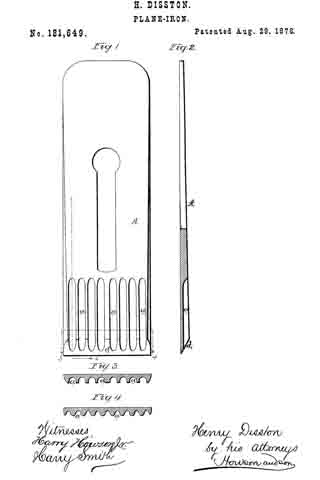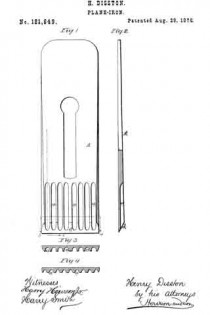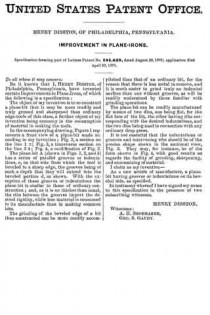No. 181,649 – Improvement In Plane-Irons (Henry Disston) (1876)

UNITED STATES PATENT OFFICE.
_________________
HENRY DISSTON, OF PHILADELPHIA, PENNSYLVANIA.
IMPROVEMENT IN PLANE-IRONS.
_________________
Specification forming part of Letters Patent No. 181,649, dated August 29, 1876; application filed April 29, 1876.
_________________
To all whom it may concern:
Be it known that I, HENRY DISSTON, of Philadelphia, Pennsylvania, have invented certain Improvements in Plane-Irons, of which the following is a specification:
The object of my invention is to so construct a plane-bit that it may be more readily and truly ground and sharpened than ordinary edge-tools of this class, a further object of my invention being economy in the consumption of material in making the tools.
In the accompanying drawing, Figure 1 represents a front view of a plane-bit made according to my invention; Fig. 2, a section on the line 1 2; Fig. 3, a transverse section on the line 3 4; Fig. 4, a modification of Fig. 3.
The plane-bit A (shown in Figs. 1, 2, and 3) has a series of parallel grooves or indentations, a, on that side from which the tool is beveled to a sharp edge, the grooves being of such a depth that they will extend into the beveled portion d, as shown. With the exception of these grooves or indentations the plane bit is similar to those of ordinary construction; and, as it is no thicker than usual, the ribs between the grooves impart the desired rigidity, While less material is consumed an its manufacture than in making common bits.
The grinding of the beveled edge of a bit thus constructed can be more readily accomplished than that of an ordinary bit, for the reason that there is less metal to remove, and it is much easier to grind truly an indented surface than one without grooves, as will be readily understood by those familiar with grinding operations.
The plane-bit can be readily manufactured by means of two dies, one being flat, for the flat face of the bit, the other having ribs corresponding with the desired indentations, and the two dies being used in connection with any ordinary drop press.
It is not essential that the indentations or grooves and intervening ribs should be of the precise shape shown in the sectional view, Fig. 3. They may, for instance, be of the form shown in Fig. 4, with good results as regards the facility of grinding, sharpening, and economizing of material.
I claim as my invention —
As a new article of manufacture, a plane-bit having grooves or indentations on its beveled side, as specified.
In testimony whereof I have signed my name to this speciiication in the presence of two subscribing witnesses.
HENRY DISSTON.
Witnesses:
A. H. SHOEMAKER,
GEO. S. GAUDY.


